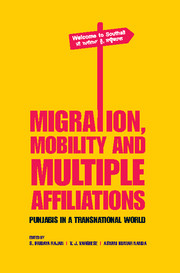Book contents
- Frontmatter
- Contents
- List of Tables and Figures
- Preface
- Acknowledgements
- Transnational World and Indian Punjab: Contemporary Issues
- Part I A Historical Survey
- Part II Shifting Contours of Migration
- Part III Social Structures and Organizational Links
- Part IV Education and Migration
- Part V Family Networks
- 13 Punjabis in Italy: The Role of Ethnic and Family Networks in Immigration and Economic Integration
- 14 Gender, the Life Course and Home Making across Tanzania, Britain and Indian Punjab
- 15 Inter-generational Tensions and Cultural Reproduction in a Punjabi Community in England
- Contributors
- Index
13 - Punjabis in Italy: The Role of Ethnic and Family Networks in Immigration and Economic Integration
from Part V - Family Networks
Published online by Cambridge University Press: 05 March 2016
- Frontmatter
- Contents
- List of Tables and Figures
- Preface
- Acknowledgements
- Transnational World and Indian Punjab: Contemporary Issues
- Part I A Historical Survey
- Part II Shifting Contours of Migration
- Part III Social Structures and Organizational Links
- Part IV Education and Migration
- Part V Family Networks
- 13 Punjabis in Italy: The Role of Ethnic and Family Networks in Immigration and Economic Integration
- 14 Gender, the Life Course and Home Making across Tanzania, Britain and Indian Punjab
- 15 Inter-generational Tensions and Cultural Reproduction in a Punjabi Community in England
- Contributors
- Index
Summary
Introduction
Little is known about Punjabis living in Italy. For this reason, before focusing on the main subject of this essay, it is essential to provide a synthetic overview on the theme. This chapter is divided in two parts: in the first, the attention is focused on stages of migration from Punjab to Italy, on main immigration channels and on current zones of settlement of the Indian population; these remarks are contextualized with respect to the main features of immigration processes and policies in Italy. Instead, the second part refers to a specific territorial context (the Emilia Romagna region, placed in Northeast Italy) and provides a qualitative and empiric cut; a synthetic analysis of the role of ethnic and family transnational networks of Punjabis in the migration and economic integration dynamics. The analysis concerns first generation immigrants.
To bring forth the discourse, it is necessary to clarify shortly some theoretical premises. In sociological literature the concept of transnationalism is declined in various ways to study migration processes. For example, a distinction is done between ‘broad’ and ‘narrow’ transnationalism: even if it is assumed that they are mutually constitutive phenomena (Gardner 1995; Salih 2001), the first concept is brought back to the whole of the economic and political processes happening at a global level across the borders of nation-states, while the second concerns dynamics that occur between migrant communities and people and places in the countries of origin (Basch, et al., 1994; Taylor et al., 2010). This chapter refers to an even stricter or ‘feeble’ definition of transnationalism (Ambrosini, 2008), based mainly on the study of concrete actions and on social and relational networks of individuals. It focuses on transnationalism ‘from below’ (Smith and Guarnizo 1999) and the analysis is conducted at a micro-social level. This has precise consequences: for example, the study of migrants’ transnational living (Guarnizo, 2003; Portes, Guarnizo and Landolt 1999; Portes 1999) concerns the analysis of how social and kin-networks in Italy are redefined, which are their internal rules and how these networks change themselves through time across the borders of nation-states, thanks to the actions of their members. To do so, the author will refer in the chapter to the concept of ego-centered network (Kapferer, 1995), i.e., all direct relations that link one specific Ego with other individuals and all relations that link those individuals among them in one specific (transnational) situation.
- Type
- Chapter
- Information
- Migration, Mobility and Multiple AffiliationsPunjabis in a Transnational World, pp. 319 - 337Publisher: Cambridge University PressPrint publication year: 2015
- 4
- Cited by



